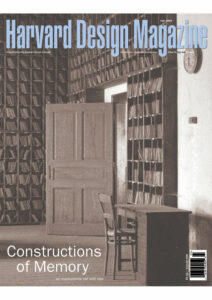Make History, Not Memory
Today, culture lives under the sign of Mnemosyne, goddess of memory and mother of muses. Memoirs, memorials, and revivals abound. In architectural writing, too, memory rules the roost. With this issue, Harvard Design Magazine joins other architecture publications titled or themed “memory.”
History’s Critique of Memory
For some time, historians and philosophers have attacked as “neurasthenic and disabling” the “surfeit of memory,” in the historian Charles Maier’s words.1 Memory’s repetitive fixations and self-centeredness, so the argument goes, preclude engagement, agency, and progressive change. History, it is said, surpasses memory when it comes to making the past matter, in the present and future. The historian’s critique of memory has so far eluded architectural discourse; the aim of this essay is to help it register.
Memory, conventionally understood, consists of personal recall and reconstruction of past events. Necessarily, it involves forgetting. History, conventionally understood, represents culture’s official explanation of the past. It, too, has its elisions.
For a famous monument of history, not memory, take the Robert Gould Shaw and Fifty-Fourth Regiment Memorial (1897), designed by Augustus Saint-Gaudens and located on the Boston Common. One side faces the Massachusetts State House, depicting in sculpted relief the white Colonel Shaw mounted alongside his black foot soldiers as they march together toward Fort Wagner and death. The other side of the memorial faces the Boston Common, describing in words white honor and black courage, and glossing Saint-Gaudens’s image. The lessons of the Shaw memorial are lucid and memorable: military service models and justifies a wider racial polity. The classical frame, too, by architect Charles McKim, unifies and elevates the message for contemplation. And the siting of the memorial directs its lessons toward future action in the State House and on the Common—in politics and society. At the Shaw memorial, history overwhelms remembrance. Motivational meaning subsumes personal memory, here delimited to details of the soldiers’ raiments and evocations, perhaps, of parades gone by.
For some time now, the kind of history embodied in the Shaw and Fifty-Fourth Regiment Memorial has seemed suspect. The monument’s idealized representations elide war’s horrors. Its didacticism smothers personal engagement. Hierarchies of race and privilege remain intact. Its illusions of objectivity veil ideological agendas.
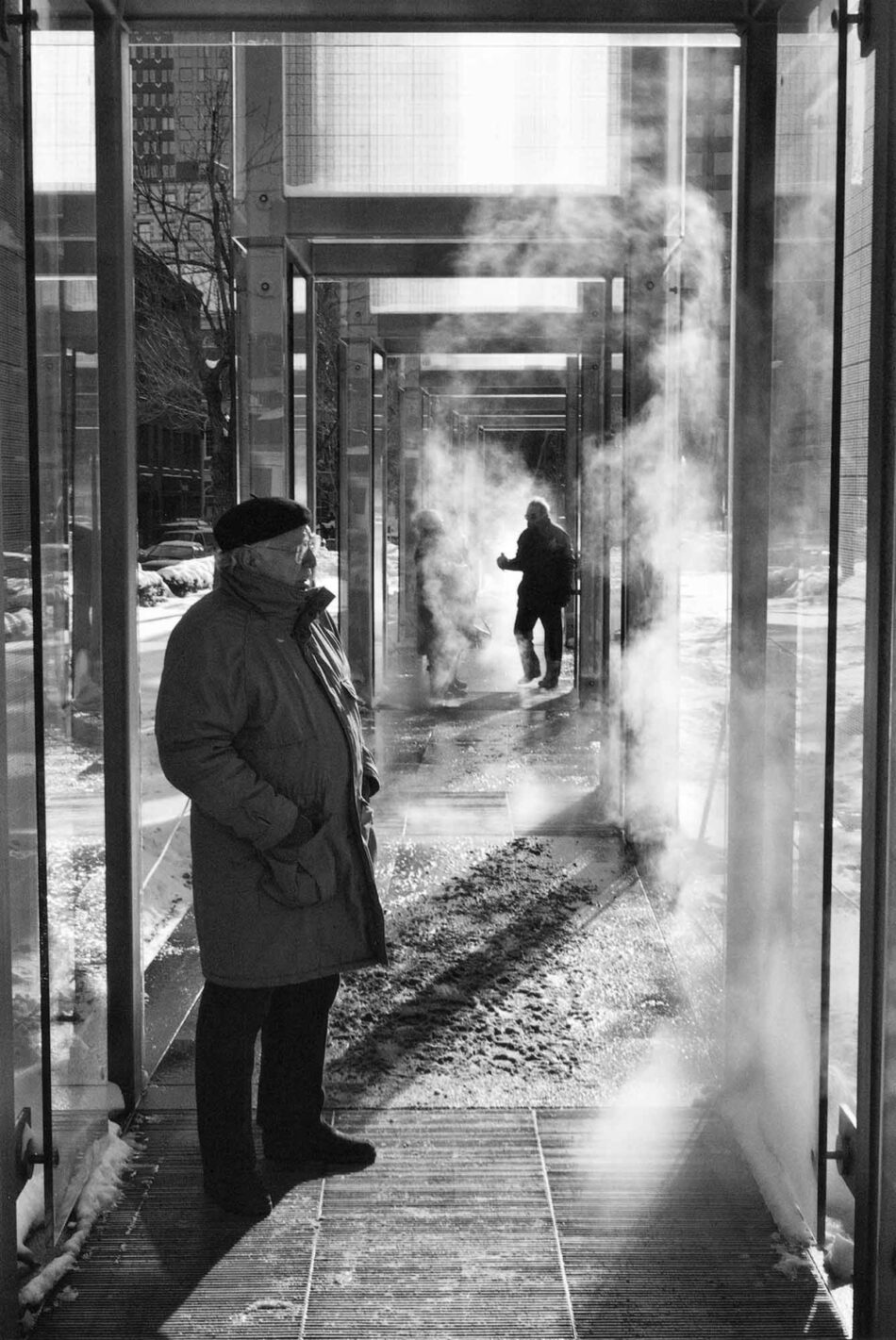
Against the apparent biases of history, memory stirs. Memory privileges the private and the emotional, the subjective and the bodily. Against history’s rationality, the reveries of memory rebel. Against history’s officialism, memory recalls hidden pasts, the lived and the local, the ordinary and the everyday. Against history’s totality, memory’s pluralism blooms. “In modernity memory is the key to personal and collective identity,” writes Michael Roth.2 Against the century’s dislocations, memory anchors the self. “Today everyone is his or her own historian,” writes John Gillis.3 Against the century’s traumatic horrors, memory authenticates redemptive witnessing. Against the century’s rootlessness, memory valorizes the aura of place. In a forgetful century, memory resists. In an age of archives, memory yearns. “Memory is constantly on our lips because it no longer exists,” writes Pierre Nora, the great historian of French national memory.4 Memory can be neither dispossessed nor interrogated. Personal or collective, memory cannot be dictated. It is sacral, innocent, and immediate. It works freely by evocation, similarity, metaphor. Memory dreams in fragments, gaps, and dissipation. It is multiple and promiscuous. Rejecting objectivity and factualism, memory values representation and the rememberer.
Memory’s paradigms suffuse contemporary culture. Memoir writing is one manifestation. So is museum and memorial building. Historic preservation is another, as is the related phenomenon of topophilia, the fetishizing of place.
At another level, memory’s critique of history reverberates in Michel Foucault’s influential theories of ironic “counter-memory” and “effective” history, “with its moments of intensity, its lapses, its extended periods of feverish agitation, its fainting spells . . .”5 Similarly, the urban historian M. Christine Boyer writes that “to read across and through different layers and strata of the city requires spectators [to] establish a constant play between surface and deep structured forms, between purely visible and intuitive or evocative illusions.”6 Under the spells of memory and irony, the past’s reality is lost to the present and foretells no future.
The eclipse of history by memory has profoundly influenced modern commemorative sculpture, architecture, and public space. Modernism, similarly in flight from tradition and history, and in pursuit of rational utility and relevance, violently rejected the past’s models, lessons, and admonitions. Le Corbusier’s urban visions, for one example, never allowed for monuments or memorials. Boston’s City Hall Plaza, for another—a work of the Late Modernist years of the 1960s—is shaved nearly clean of history.
City Hall Plaza is all fluid, dynamic presence, setting the individual loose in space. No didactic object mediates between the citizen and City Hall. The plaza’s one diagonal vector converges conveniently on a subway entrance. In the northwest corner, a recessed garden refreshes the visitor—but in private, apart from the city, and without commemorative intrusion.
Nearby lie exemplary objects of Modernist commemoration. Off Cambridge Street, obscured by a planter, stands a waist-high granite marker, on which an uptilted plaque reads: “Here, on June 2, 1875, Alexander Graham Bell and Thomas A. Watson first transmitted sound over wires. The successful experiment was completed in a fifth floor garret at what was then 109 Court Street and marked the beginning of world-wide telephone service.” Birthplace of the First Telephone modestly recalls a lost everyday world of garrets and row houses. It celebrates a site, carefully avoiding historical pedantry (except obliquely, about the importance of Boston).
Nearby, in front of the Kennedy Federal Building, stands another Modernist work: Thermopylae, a sixteen-foot-high bronze sculpture by Dimitri Hadzi. The floating, bulbous forms, a plaque tells us, were “inspired by Profiles in Courage and the brilliant war record of President John F. Kennedy,” and are “thoroughly symbolic in [their] abstract shape.” “Through the effect of the sun, rain, and snow on the sculpture,” the inscription concludes, “the viewer is provided with ever-changing visual and emotional experiences.” The abstraction of Thermopylaeabjures didactic representation and hence invites the viewer’s unmediated response. The text claims one set of generative associations, but the form itself imposes no meaning. A spellbinding aura of immediacy sets the beholder free in time and imagination. Thermopylae, like Birthplace of the Telephone, is an altogether typical Modernist “monument.” History has no purchase here. The traditional monument seems dead and buried. Modernism forgot about monuments, or so it said. In the early 1960s, the sculptor Claes Oldenburg began fantasizing about placing in urban landscapes colossal objects he called “monuments.” “Later when I looked up the definition, I realized that ‘monument’ meant a memorial of some kind,” Oldenburg recalled, “At the beginning, I didn’t think of it that way.”7 Oldenburg’s forgetfulness, feigned or otherwise, captures the period’s amnesia. His “monument” project, which has been central to the American monument’s 20th-century development, was born from memory and “playful, personal fantasies.”8
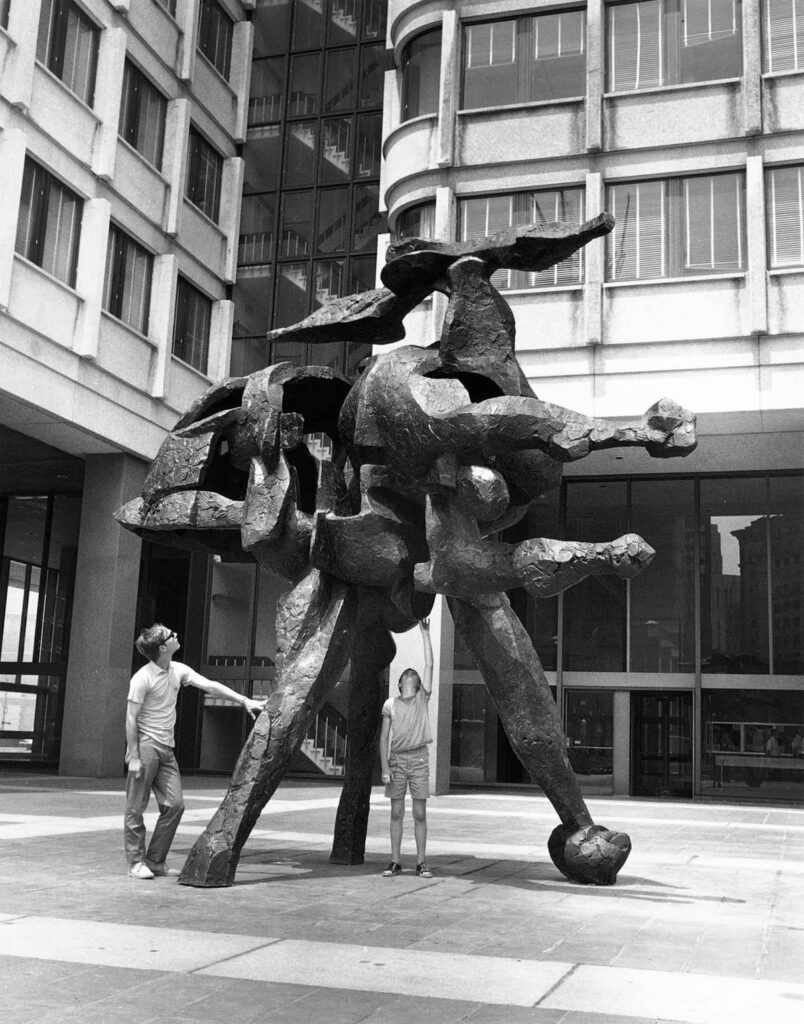
Oldenburg began conjuring, through his memory and body, associative objects that recalled for him particular cities: a colossal ironing board for Manhattan’s shape and historic laundresses, colossal knees for London’s dampness, cramped cabs, and mini-skirts. The artist’s first surrealist “monuments” reflected personal memories and psychic dramas. Then, in the mid-’60s, his project took a decisive turn. Oldenburg began imagining counter-monuments dedicated to historical figures—like an upside-down buried mold of JFK—as well as a series of “obstacle monuments” whose theme was the decade’s urban violence. On the site of Buckingham Fountain in Chicago’s Grant Park, for example, Oldenburg pictured a giant windshield wiper, evocative to him of the tapering form of the nearby Hancock Tower and the curving loop roads of Daniel Burnham’s unrealized Plan of Chicago. In the pools below the giant wiper, Oldenburg imagined children playing: “However, from time to time the blade of the Giant Wiper descends into the water. If one doesn’t want to get hit, one must watch it and get out in time. . . . On certain days, communities throughout the city may decide on a different pace. A button in the Art Institute will adjust it all. . . . The Wiper is as cruel as death because it comes down into the water where the kids are playing. . . . the Wiper can ‘kill’ kids if they don’t learn how to get out of the way.”9
Oldenburg’s wiper captures the memory project perfectly, but blends it with old-fashioned exhortation. A previous monument—Buckingham Fountain—is overturned. Personal memory and site generate form. A quotidian object assumes monumental import. Ordinary people control its action. Existential trauma finds a focus. Irony creates distance, as in Foucault. But more traditionally, the monument also tries to teach explicit lessons about how to conduct oneself in public. In effect, Oldenburg’s 1960s proposals for monuments infuse personal memory with hortatory significance, and in so doing begin to counter Modernism’s amnesia, its obliviousness to traditional monumentality and history.
Also in the mid-’60s, Robert Venturi similarly proposed evoking memory and manipulating scale to create meaningful public space. In 1966 Venturi entered a competition for the redesign of Copley Square in Boston. In the broad plaza between Trinity Church and the Boston Public Library, Venturi proposed a grid of walkways and step-mounds, deliberately recollecting the surrounding gridiron of the Back Bay. Inset into one block would be a small-scale replica of Trinity Church. “The miniature imitation is a means for explaining to a person the whole which he is in but cannot see all of. To reassure the individual by making the whole comprehensible in this way within a part is to contribute a sense of unity to a complex urban whole.”10 Thus Venturi puts ordinary experience and local memory in the service of civic therapy. Memory’s playfulness and dreamlike mechanisms persist. But Modernism’s solipsistic abstractions subside. Legibility reappears, as does explicit urban orientation and exemplary lesson-giving.
Venturi’s unrealized Copley Square project occupies a singularly important although unacknowledged position within the architect’s subsequent work as well as within American urbanism generally. It is the progenitor of the architect’s Western Plaza in Washington (1977) and Welcome Park in Philadelphia (1982), and also the antecedent, I would suggest, of all other urban spaces that feature pavement maps and other literal representations of place.
Together, Oldenburg and Venturi’s mid-1960s projects activated a “postmodernist” convergence of memory and history, and are part, perhaps, of a secret history of American monumentality. In 1969, at the invitation of Yale architecture students, Oldenburg realized in built form his first monument: a colossal, inflatable, tractor-mounted red lipstick, which reiterated an earlier proposal for London and was here placed in front of a university war memorial to protest (through satire) the Vietnam conflict. Venturi, too, had a Yale connection beginning in the 1960s, through the architecture school and the architectural historian Vincent Scully. In 1980, again at Yale (perhaps coincidentally, perhaps not), an architecture undergraduate named Maya Lin writ large the next chapter in American monumentality.
Lin’s Vietnam Veterans Memorial is too famous to require elucidation here.11 Suffice it to say that its extraordinary success has depended in large measure on its combination of Modernist memory, traditional history, and one key innovation. In terms of memory’s maxims, the Vietnam Memorial foregrounds and recalls ordinary naming, without rank or hierarchy. It avoids didacticism in favor of subjective emotion and immediacy. Mirrored surfaces, tactile inscriptions, and spontaneous acts of name-rubbing and memento-leaving create a place of profound personal transaction and trauma therapy. In form, the memorial seems a kind of Modernist “counter-monument”—abstract, horizontal, and black—which is of course what upset its early critics, now silenced, like Ross Perot and Tom Wolfe.
At the same time, Lin renewed many of traditional monumentality’s formal and conceptual themes. Like the Shaw and Fifty-Fourth Memorial, the Vietnam Memorial is frontal, unified, legible, and textual. It provides a place for contemplative reading. It links past to present directly, through the orientation of the walls to the Lincoln Memorial and the Washington Monument. And cautionary lessons are to be learned here about the profound losses of war.
Lin’s innovation is to arrange the names of the dead chronologically, from the vertex outward to the east and then back around from the west to the center. In effect, she creates a time line—the 20th-century schoolroom’s classic mnemotechnology—which in turn engenders an idealized historiography of the war’s trajectory, perfect in its narrative symmetry and closure. The ground dips and rises as catharsis. The time line’s circularity symbolizes the closure we desire when thinking about this particular war.
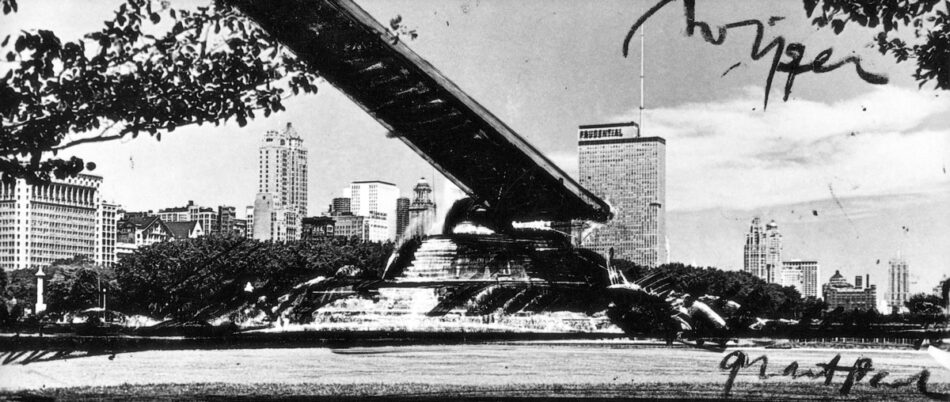
The Vietnam monument anticipated the architect’s other time-line-focused projects—the memorial to the Civil Rights movement in Montgomery, Alabama, and the monument to coeducation at Yale in New Haven. More broadly, the Vietnam Memorial inspired the monument and memory revival we continue to live through today. Like the once-scorned Vietnam veterans, many other American special-interest groups have staked legitimate claims for attention and respect through monuments and memorials. Shiny black granite walls with etched names populate the American landscape. Places of trauma and memory proliferate, from the populist spontaneity of roadside accident memorials and the Oklahoma City bombing site to the skillful oppositional politics of the Power of Place project that memorializes Los Angeles’s hidden ethnic and female histories.
Nearly all these monuments operate under the sign of memory. They repudiate traditional representation and hortatory narrative. They disdain inauthentic officialdom and pedantic inscription. They are partial to the everyday and revealed history. They favor subjective response and emotional immediacy. They deploy testimonial, witnessing, oral history, and letter writing. They employ modest and often fragmentary forms. They sponsor topophilic identities. “Places make memory cohere in complex ways,” writes Dolores Hayden, who helped to create the Power of Place project.12 They sanctify archival memory. Every object left along the walls of the Vietnam Memorial is warehoused permanently by the National Park Service. Memory reigns over history.
Meanwhile, a backlash against memory gathers steam. Historians note that memory is just as malleable, arbitrary, and forgetful as history. “Although written history can never be complete, memory must inevitably be much less so,” declares Michael Kammen.13 Memory, it is argued, gives way too easily to nostalgia’s redemptive returns and fictive wholeness. Marketers commercialize memory as commodity, further encouraging passive consumption of the past. “Memory has thus become a best-seller in consumer society,” bemoans the historian Jacques Le Goff.14
Treated as personal or collective property, memory encourages solipsistic self-indulgence and exclusionary identities. Sacralized memory admits neither debate nor revision. Memory’s compulsive repetitions produce neurasthenia. Emphasis on remembered representations of the past, and the rememberer’s consciousness, veil the actual objects of memory. Memory’s spell enervates. “The past is brought back in all its richness,” writes the landscape critic J. B. Jackson. “There is no lesson to learn, no covenant to honor; we are charmed into a state of innocence and become part of the environment. History ceases to exist.”15
Most damning of all, some charge that memory’s complacency, repetitions, and exclusions lead to the failure to progressively engage the past and present with the future. “Effective agency may have to go beyond witnessing to take up more comprehensive modes of political and social practice,” suggests the literary critic Dominick LaCapra.16 “The surfeit of memory is not a sign of historical confidence but a retreat from transformative politics,” declares the historian Maier. “It testifies to the loss of future orientation.”17
In place of the dominance of flawed memory over history, some critics and historians propose instead a relationship of mutual interdependence in which “memory is the raw material of history,” and “the discipline of history nourishes memory in turn.”18 Others suggest a more dialectical antagonism between history and memory. “It is the tension or outright conflict between history and memory that seem necessary and productive,” write Randolph Starn and Natalie Zemon Davis. “Memory and history may play shifting, alternately more or less contentious roles in setting the record straight.”19 A third approach would give history priority over memory, beginning with history’s responsibility to test critically the claims of memory. These formulas also attempt forcefully to break through memory’s solipsism and create spaces for broader engagement that might lead to progressive change. And they counter the ironic detachment characteristic of Foucault’s idea of history as “dissipation.”
Michael Roth, for example, calls for a new model of “pious” engagement with the past, an engagement transcending irony; he specifically encourages a “posture of receptivity” and “the placing of oneself in relation to the past in its otherness and potential connection to oneself.”20 Emphasizing the need for “a social structure in which people can address each other across the boundaries of difference,” the sociologist Richard Sennett writes of “the liberal hope for collective memory,” in which “many contending narratives are necessary to establish painful social facts. It is only the noise of contention which wrests collective memory from that shared, dream-like state we call myth-making.”21 LaCapra draws from psychoanalysis the idea of “working through the past,” which would “involve a modified mode of repetition offering a measure of critical purchase on problems and responsible control in action that would permit desirable change.” “Working through” would require “the generation of a transformed network of relations that counteract victimization and allow for different subject-positions and modes of agency.”22
These important new ways of thinking about history and memory attempt to correct memory’s repetitive fixations, its emphasis upon victimization and domination, and its passivity and self-contentedness. In place of compulsive aural memory and ironic discursive detachment—both of which disengage the past from the present and future—these new models propose engaged, critically tested, and debatable connections between past, present, and future. What they possess in common is the application of historical criticism, coherence, debate, empathic imagination, and exhortation to the task of making personal and collective memory productive for the future. In effect, these new models call for “working through” the memory and irony obsessions of our contemporary culture with the aid of history’s tools and aims.
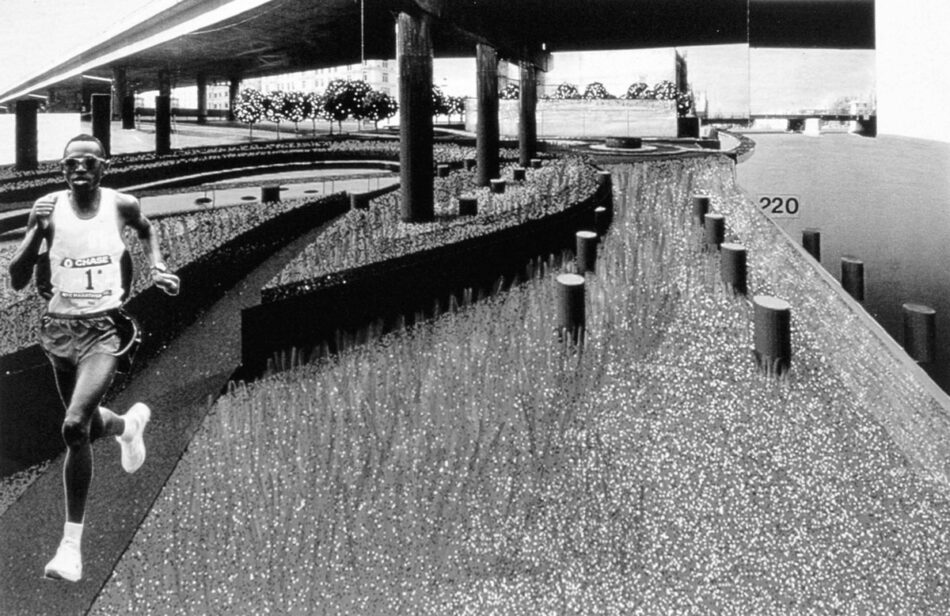
Have these new formulations and the backlash against memory registered in monument building? Architects like Peter Eisenman and Daniel Libeskind play ironic memory games in their museums and monuments, producing interesting forms that possess little coherence and hence discourage debate and paralyze action. Many other contemporary monuments encourage witnessing and archival memory as their primary modes of commemoration. Both the recent Franklin Delano Roosevelt and Korean War Memorials in Washington authenticate their subjects with quotations, reproductions of famous images, and even photographs. Similarly, other monuments use inscribed testimony and letters to evoke personal, everyday memory and to tug at our heartstrings. What is missing is any historical framework or sense of the future.
Admittedly, monument making should not be expected to accomplish the same things as historical discourse. We cannot realistically expect, for instance, that a monument will spur debate about its subject within itself. Nor should we anticipate that monument makers will get out ahead of the public (which commissions monuments, after all) and its still strong interest in memory.
What we might expect from monument making is an attempt to begin the working through of memory’s problems. The historians’ critique alerts us to memory’s flaws and limitations, particularly its solipsism and disengagement from agency. New postures of receptivity and explicit inspirational intention might help create the kinds of “civil spaces” invoked by John Gillis, in which “individuals come together to discuss, debate, and negotiate the past and, through this process, define the future.”23
One example of a monument that wrestles productively with the relationship between history and memory is the New England Holocaust Memorial by Stanley Saitowitz (1993). Six tall glass towers built in six stages and engraved with 6 million individual numbers enclose visitors who read survivors’ etched testimonials. These are Modernist memory towers: sacralizing survivors’ memory, abstractly evoking death camp confinement and crematoria smokestacks, and acting as memorable mnemonic devices to help us recall the six million Jewish dead. In between each tower a black stone walkway documents in simple declarative prose some history of the Holocaust: its classes of victims, its Gentile and Jewish resisters. In effect, the memorial mixes and alternates memory and history. It combines prefatory injunctions to “Remember” with an introductory narrative time line. It tries to make the survivors’ memories part of history and the Holocaust’s history part of our personal memory.
Less charged events, too, are susceptible to the effective blending of memory and history. For several decades, the artist Mary Miss has created public spaces fundamentally concerned with the everyday engagement of visitor’s memories and fragmented local topographies and architectures. South Cove in Manhattan’s Battery Park City (1987) is her most famous work. With its strewn boulders and recreated dock pilings, South Cove recalls the Hudson River’s natural and maritime past; with its crown-like overlook, it also evokes the nearby Statue of Liberty. Rooted in the memory paradigm, Miss’s work transcends it as well. The artist engages with clients, design collaborators, and community users in a dialogic process echoing revisionist formulas for correcting memory’s solipsism. Miss’s work straddles, too, the sphere between private imagination and public space. Significantly, in her most recent projects, Miss has begun to conceive more explicitly the connections between her work’s longstanding concern with evoked memory and engaged presence, on the one hand, and its applications to the future, on the other. Describing a current project for Milwaukee’s Historic Third Ward Riverwalk, Miss declares that her riverside park of walkways, viewing platforms, and plantings will be “an area where the history as well as the future of the river can be explored and imagined.”24 Along the bend of the Milwaukee River, Miss plans on “calling out and taking notice of infrastructure,” thematizing the shoreline’s ancient wetlands as well as its modern stormwater treatment systems.
These projects by Saitowitz and by Miss work through memory toward history. Significantly, they do not return nostalgically to premodern monumentality. They do use Modernism’s formal tools and agendas, as well as memory’s purchase. Their abstract and open forms encourage multiple interpretations. But they also value history’s structure and animating potential. They resist irony and risk conviction. They encourage the receptivity of visitors who are made newly aware of history’s facts, meanings, and lessons.
The time has come to work through memory toward history. History means critical distance and empathic engagement. History does not mean abandoning memory. History is memory critically tested and imaginatively engaged. History means making the past work, in the present and for the future. Monuments, like history, ideally connect the past to the future through present engagement and hortative content. If the public is content merely to remember the past, then the powerful will be entrusted too fully with planning the future. Change demands engagement, which entails conviction; conviction allows debate, which leads to change. Memory cannot be debated; history can. Make history, not memory.
24 Mary Miss, “Milwaukee River Project: Historic Third Ward Riverwalk,” unpublished concept plan, December 1998.
Daniel Abramson is assistant professor of art history at Tufts University and author of a forthcoming book on Mary Miss.
